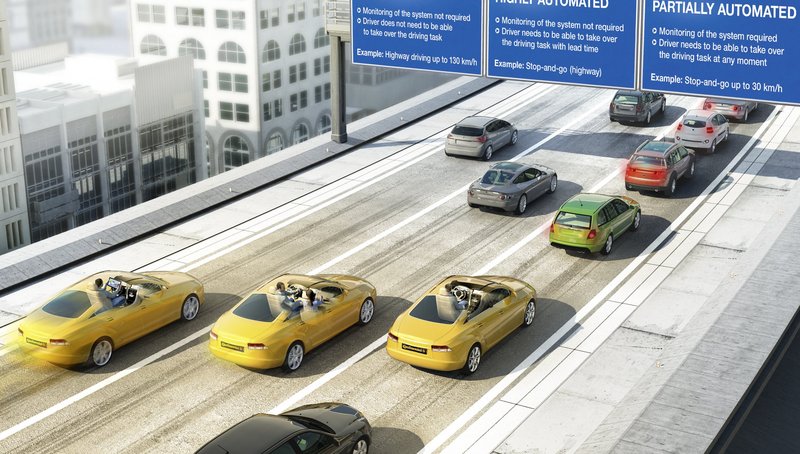Continental Strategy Focuses on Automated Driving
- Progressive automation by 2025: Partial automation possible as early as 2016
- More than 1,250 specialists employed by the automotive supplier are already working on automation
- Increased safety, greater freedom for the driver, improved efficiency: Automated driving will change individual mobility considerably
Hanover, December 18, 2012. The development of products and systems for automated driving is one of the central themes of international automotive supplier Continental's long-term technology strategy. "Over the last few weeks, we on the Executive Board have considered the strategic and budget planning for our five divisions for the coming year in great detail. For our automotive divisions, this planning includes all of the necessary elements that need to be implemented step-by-step across the board so that fully-automated driving becomes reality by 2025," said Dr. Elmar Degenhart, Chairman of the Executive Board of Continental, after the end of the Strategy Workshop.
"At Continental, we will be investing billions overall in research and development over the coming years particularly in the automotive divisions to help smooth the path to the mobility of the future," explained Degenhart. "It's clear to us that automated driving will be a key element in the mobility of the future. As a system supplier, we are perfectly positioned to develop and launch series production of solutions for partially automated systems for our customers by 2016. We will be able to develop the first applications for highly and ultimately fully automated driving, even at higher speeds and in more complex driving situations, ready for production by 2020 or 2025."
Automated driving to be implemented step-by-step
From a technological point of view, automated driving represents the evolution of driver assistance systems, which have already begun to emerge. Their systematic networking with driver information and drive systems is gradually advancing the concept toward its goal. From 2016, partially automated systems may therefore be assisting drivers in "stop & go" situations on the freeway at low speeds of up to 30 km/h. But this initial step toward automation does not relieve drivers of their responsibility to constantly pay attention to what is happening on the road.
This step may come to fruition with the implementation of highly automated driving from 2020. As well as covering higher speeds above 30 km/h on the freeway, highly automated driving will allow drivers to use the time they would ordinarily spend driving to carry out other activities, such as ordering Christmas presents online. With both levels of automation, however, the driver must be able to take control of the vehicle at all times. But when fully automated driving is possible in 2025, even this may no longer be necessary.
On the freeway, a fully automated vehicle will have full and independent control of driving up to 130 km/h. But when the vehicle reaches the desired exit, for example, the driver will have to take control, even with this high level of automation. When fully automated systems become available in 2025, they will still be limited to driving on the freeway. However, if the driver fails to respond to a demand to take control here, the vehicle will return to a safe state by itself, i.e. by braking and stopping on the hard shoulder.
Disempowerment? Drive or be driven: The choice is yours
"Automated systems can increase road safety many times and therefore save lives. This is something we have already seen in the aviation industry. Similarly to the situation for pilots, automated driving systems will not at all lead to the frequently claimed disempowerment of motorists. On the contrary, the interactive and optionally automated car will give drivers more freedom in terms of individual mobility. Drivers who take the same route to work every day, for example, will surely embrace the opportunity of having the vehicle take charge of this task. The same applies to monotonous and tiring long-distance journeys on freeways," explained Degenhart.
With suitable systems on board, drivers will in the future be able to decide whether to do the driving themselves or to let the vehicle take control. With the market launch of highly automated vehicles by 2020, drivers will be able to concentrate on other activities, such as reading the latest headlines on the Internet. This will give drivers much more freedom. At the same time, an automatically controlled vehicle will be even safer thanks to the increased interaction with itself and its environment. Furthermore, the energy management and driving characteristics of the vehicle will be optimized on the basis of a real-time data concept, thereby enabling more energy-efficient driving.
The development of automated driving requires systems expertise
Today, more than 1,250 specialists at Continental are already working on the basics of automated driving. They are working specifically on driver assistance systems, such as adaptive cruise control and emergency brake assistance, which employ sophisticated technology to record the vehicle environment using a camera, infrared, and radar in various driving situations and therefore to warn, support, and relieve the driver. To enable us to focus even more on the increased demand for assistance systems, the new Advanced Driver Assistance Systems business unit was formed within the Chassis & Safety division in April this year.
Continental is already one of the leading manufacturers of driver assistance systems. Since the first series project in 1999 for the Mercedes S-Class, the company has realized more than 100 projects for automotive manufacturers worldwide. What's more, Continental's Interior division has several years of experience in the design of display and user interfaces, while the Powertrain division has a wealth of expertise in the energy management of drive systems. Integration at system level is coordinated on a cross-domain basis in strategic pre-development. In conjunction with its network of partners in the field of information and communication technology, this approach enables Continental to realize all technological aspects of automated driving. The internationally operating supplier's Chassis & Safety division can also look back on several years of development activities in the field of automation. As well as its commitment to diverse research projects (AKTIV, HAVEit, DARPA Urban Challenge), in early 2012 the company undertook a two-week endurance test with close-to-production technology in the US state of Nevada. Over 15,000 miles of highly automated driving have been completed on public roads primarily in Nevada.
Legislation is decisive when it comes to market launch
"The basic technical prerequisite for the implementation of automated driving is system reliability. Road safety of the highest degree is therefore the essential foundation on which automated driving must be based," explained Degenhart. In concrete terms, this calls for fail-safe architecture that keeps the vehicle in a safe state in the event of a fault. However, the time frame for development of this necessary safety architecture will not be the sole factor that determines the timing of market launch: "Legislative bodies will take the major decisions as to when and how automated vehicles will be introduced onto the market, and the required legal framework still needs to be drawn up," added Degenhart.




